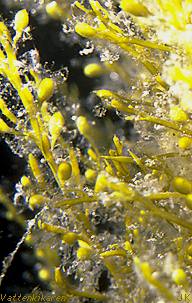 |
|
Fragmentation
does not have to occurr because of injury, but can also be a process where
a colony clones itself to produce new colonies. This means that size is
not directly related to age as it is with solitary organisms.
Size is important as it improves a colony´s chances
of survival when competing for food or from attack by predators.A quick
and effective way of increasing in size is to unite with other colonies
and for this to be accomplished, colonies must conform both genetically
and immunologically, i.e. defence. It also happens that colonies fight each
other. Colonies that do not recognize each other as being closely related
can attack other in different ways and one of them can be to grow over the
other.
Variation and change
For organisms, living conditions
can vary from place to place and with time. Attached organisms such
as microscopic diatoms
are often found directly on sand bottoms, but can, given the right
conditions show up in large numbers on cliffs and rocks. In spite
of their small size they can be easily seen during the spring and
early summer when they bloom and lay like a glittering golden veil
over other algae.
In the picture, strong sunlight shimmers around a brown
alga known as japweed (Sargassum muticum). This veil contains
diatoms and other small particles that have been caught in a sticky
and finely meshed network of microalgae. |
 |
 |
Page
14 of 52 |
 |
|
Cliffs
and rocks are fantastic! |
| Zoning
and flecked occurrence |
| Animals
that are attached |
| Modular
construction |
| Variation
and change |
| Variations
in water level |
| Wave
exposure |
| Both
cliffs and rocks |
| Freshwater
and saltwater |
| Geography,
climate and history |
| Organisms
life cycles |
| Organisms
effect on each other |
| Energy
and the flow of material |
|


